Highlights of the Amsterdam Pipe Museum
Author:
Don Duco
Original Title:
Hoogtepunten uit het Amsterdam Pipe Museum
Publication Year:
2020
Publisher:
Amsterdam Pipe Museum (Stichting Pijpenkabinet)
Pipe bowl as a padlock
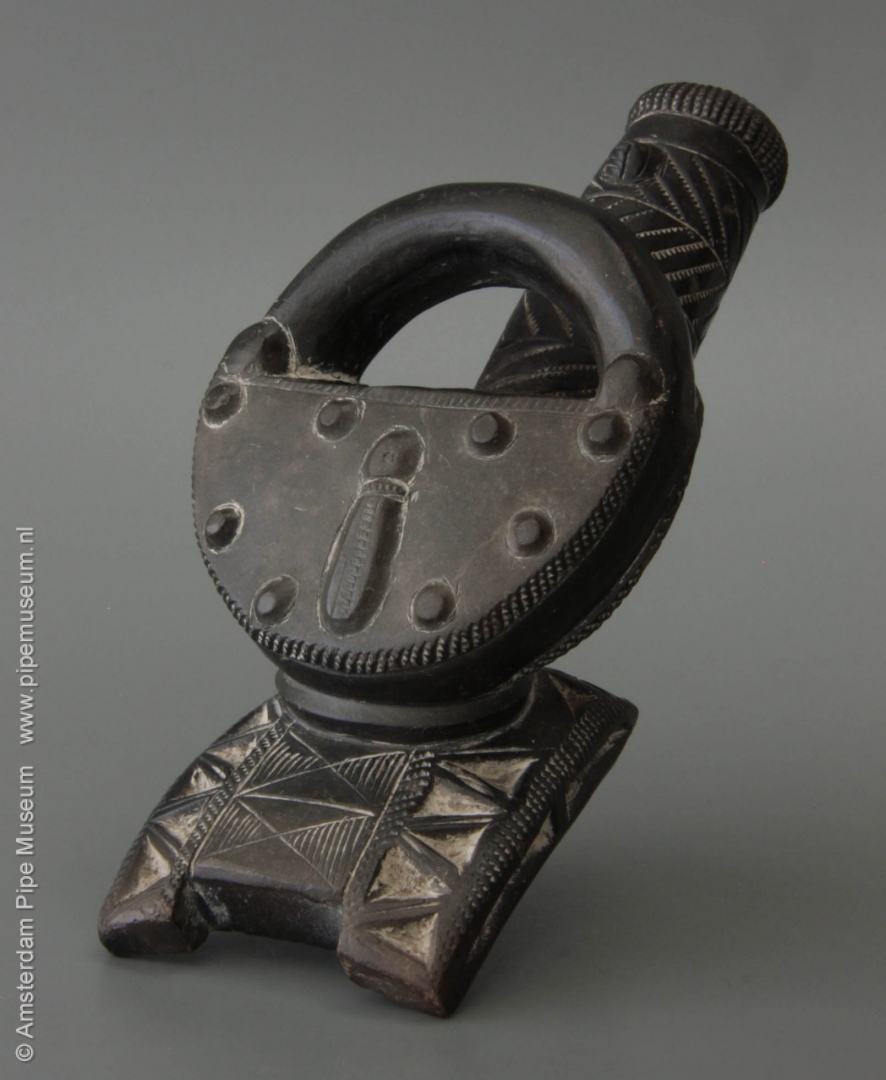
This original pipe bowl with its remarkable depiction, originates from the people living at the Gold Coast in Ghana, the Ashanti. A realistic padlock has been processed into a pipe bowl here, complete with a round shackle that protrudes above the opening of the pipe bowl. This miraculous representation is placed on a flat plinth-shaped base with two protruding points. The base is decorated with notched carvings. At the back of this object we find the upright, almost cylindrical stem that ends in an inconspicuous stub with the characteristic button just below the rim. This stem has bands with angled hatching, while the sleeve itself is decorated with vertical lines. Because of the slim lock and the typical wide but flat base, it has become an object with a very clear visible side. The front is majestic, the sides indistinct and minimal, while the back shows the original function.
The pipe belongs to the category of proverb pipes, tobacco pipes whose decoration is inspired by proverbs and sayings of the Ashanti people. The tradition of these depictions certainly goes back to the late eighteenth century. The simple and functional examples were used as everyday pipe. The more elaborately figured copies have other destinations. They were offered as a curiosity to travelers, but were mainly given a meaning in their own culture. For example, it was customary to give a pipe bowl with an appropriate depiction to the deceased as a burial gift. This tradition lasted until the nineteenth century, although with a changed modelling and way of working. It is precisely these changes in the style of the products and the detailing that make the Ashanti pipe such a challenging object of research and visual pleasure.
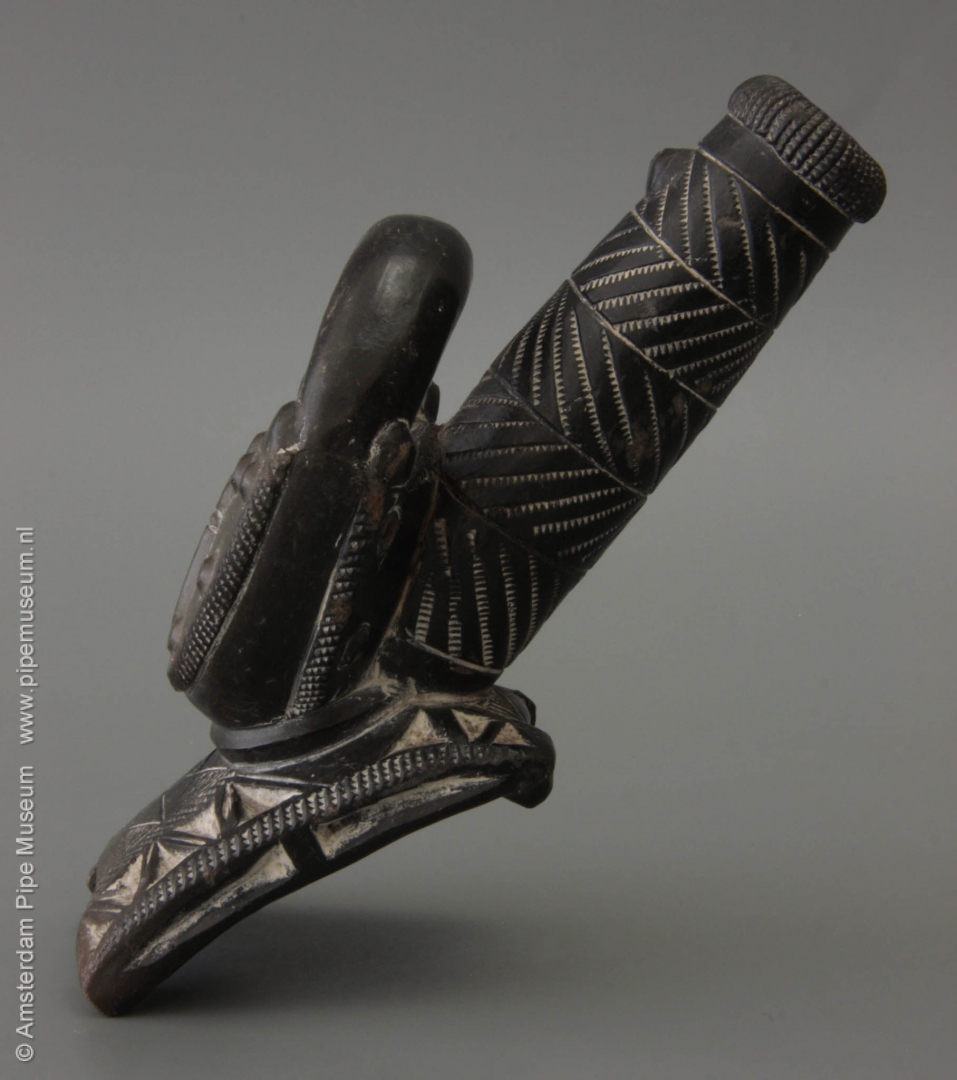
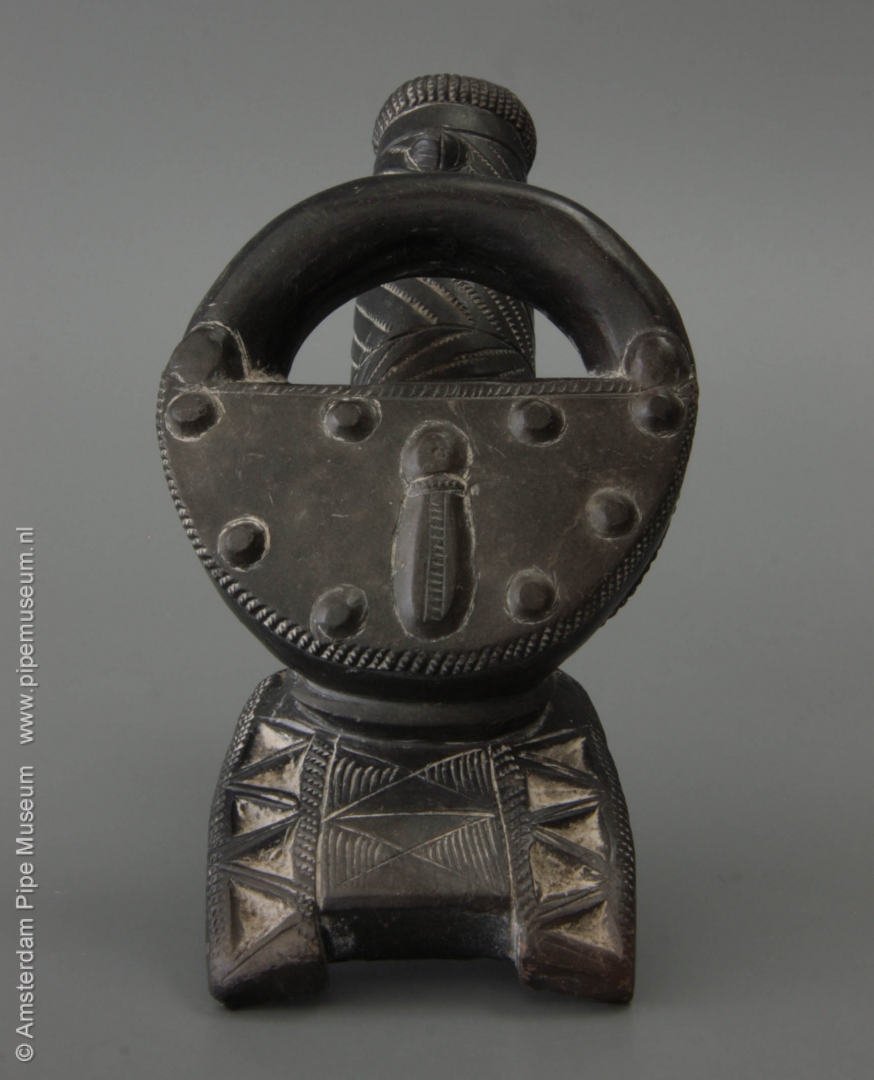
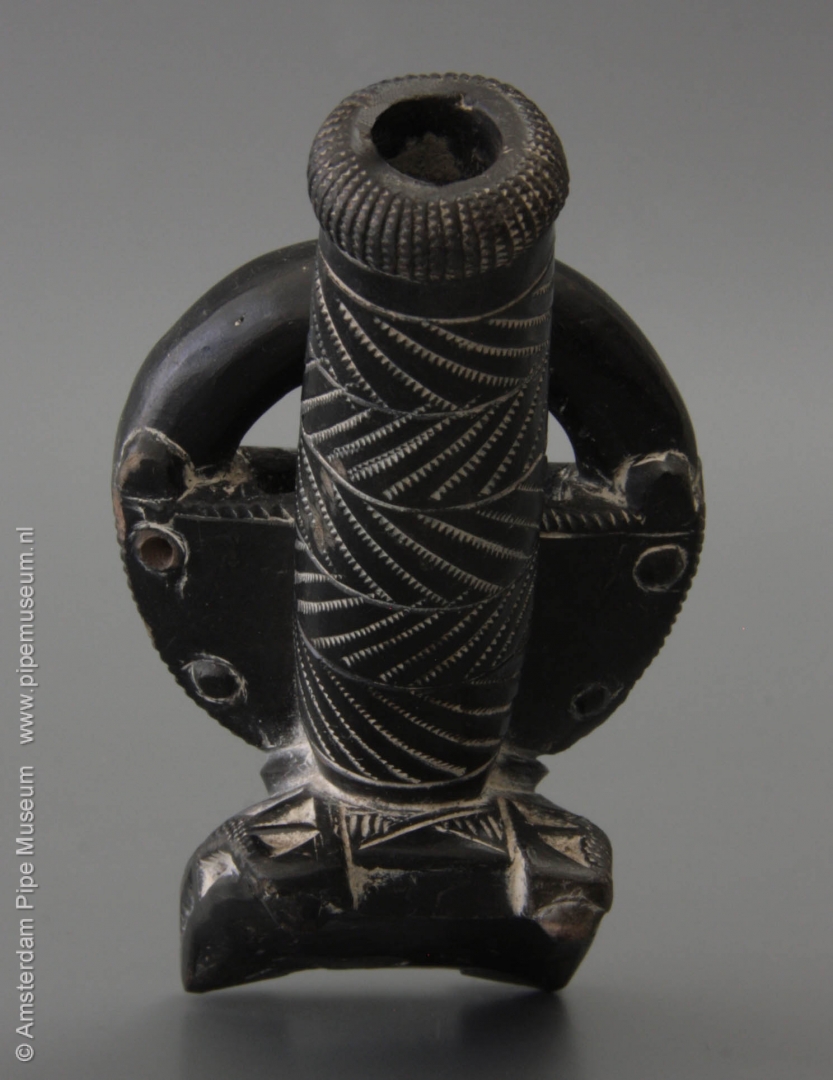
We see two finishes next to each other. The oxidizing fired pipe bowls which have a reddish-brown appearance opposite the black-smoked pipes which can have different shades of black and gray, shiny as well as matte. The popularity of both colors alternates. It was usual to rub the pipe bowls with white chalk after firing, so that the details came out better; something that we can clearly see on the back of this pipe. Given the brittle ceramics, few specimens have been preserved intact. What survived happened mainly by coincidence in old collections, especially if they were museum-managed.
When August Racinet compiled his publication on peoples with their customs and specific fashions in 1878, he drew on the pipes from the rich collection of Baron De Watteville. Among the African pipes that Racinet chose as the most stereotype at the time, there is also an Ashanti pipe bowl identical to this one, namely with a padlock. As a refined object, it stands out among the mostly bombastic and long-stemmed other pipes that he illustrates.
Amsterdam Pipe Museum APM 20.291
Two-figure pipe
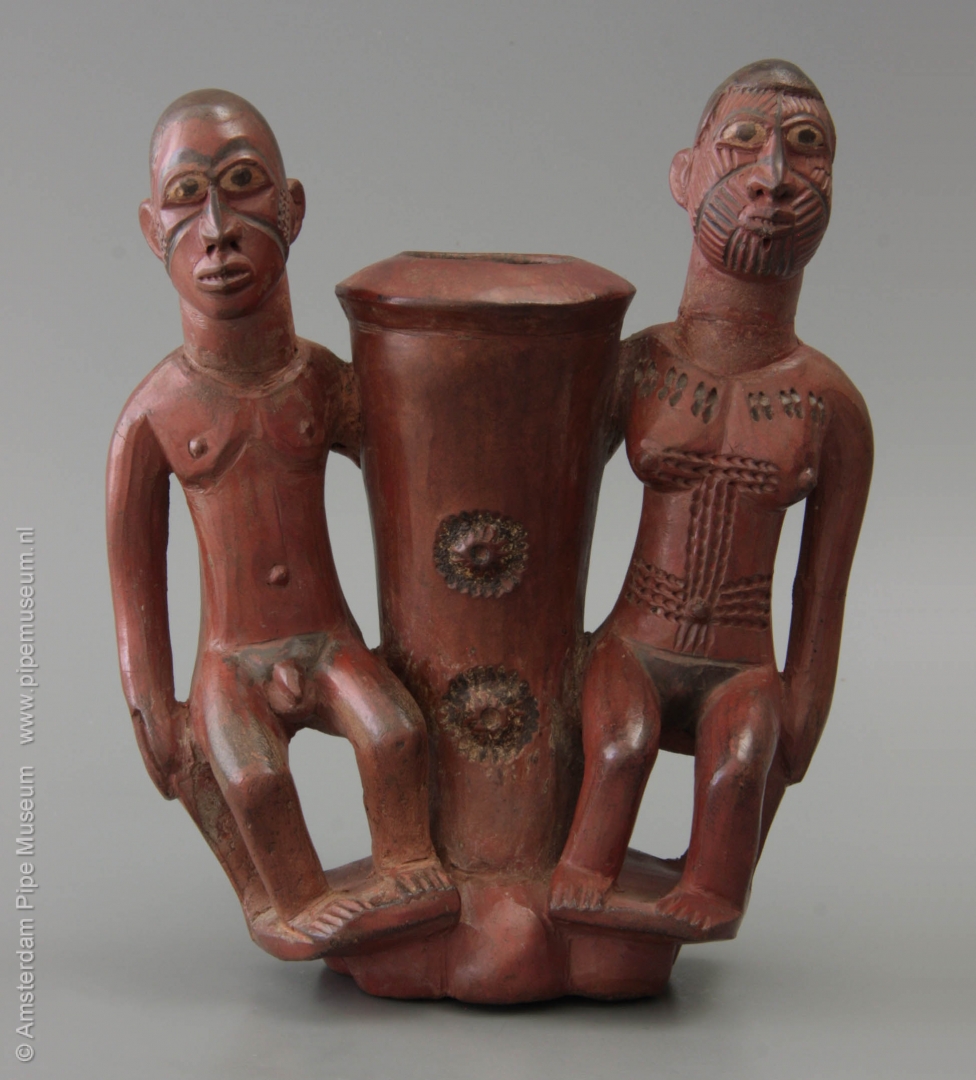
The figuration of a tobacco pipe is always a challenging affair. This object illustratres the problem. Is it a pipe with a sculpture or a sculpture with a pipe bowl in it? Modeled from earthenware, the pipe shows a cylindrical bowl with an accentuated bowl opening, placed on a larger base with seven lobes. The figural aspect can be found on both sides of the pipe bowl in the form of modeling work, in fact without any logical connection to the pipe. There we see an undressed man on the left and a naked woman on the right, both seated on a simple stool, their feet next to each other on a pedestal.
When carving the figures, most attention was paid to the face, especially the tattoos. Furthermore, the nipples and navel are explicitly marked. However, the bodies and limbs are poorly articulated, without joints or other anatomical details, only the fingers and toes have simple lines. After the depiction was modeled, the object was completely covered with a red engobe. This ensures that an attractive shine is obtained after firing.
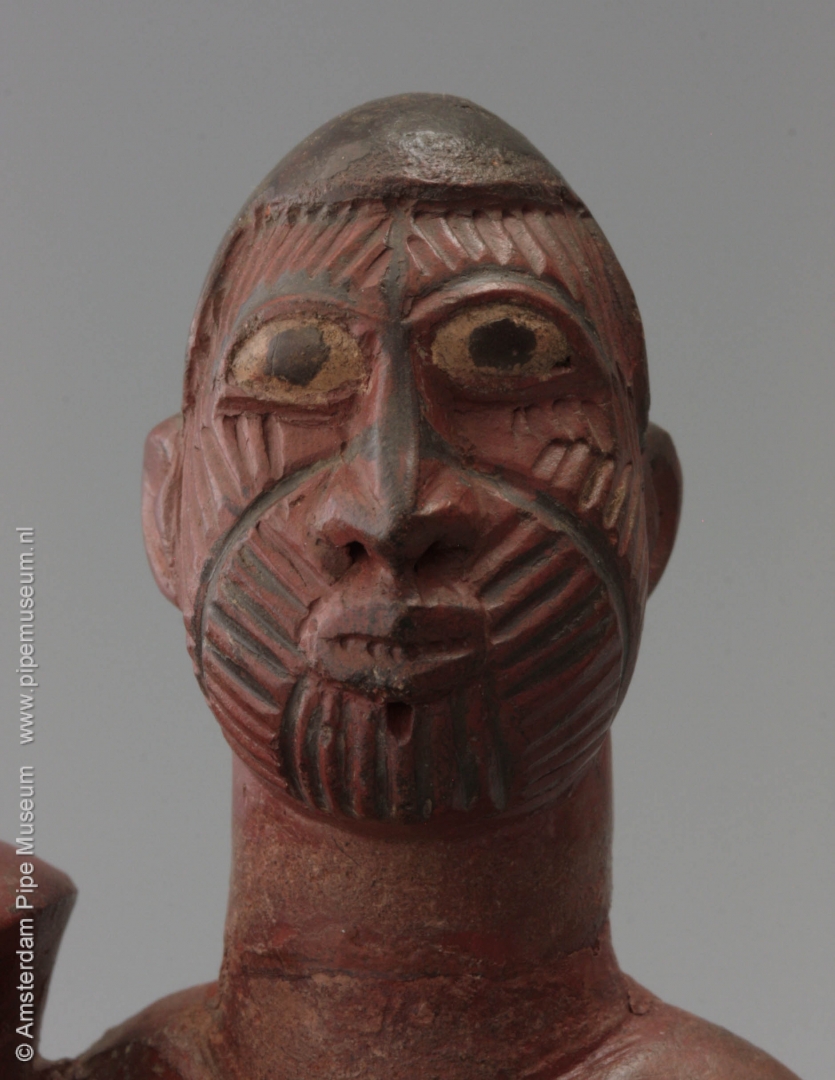
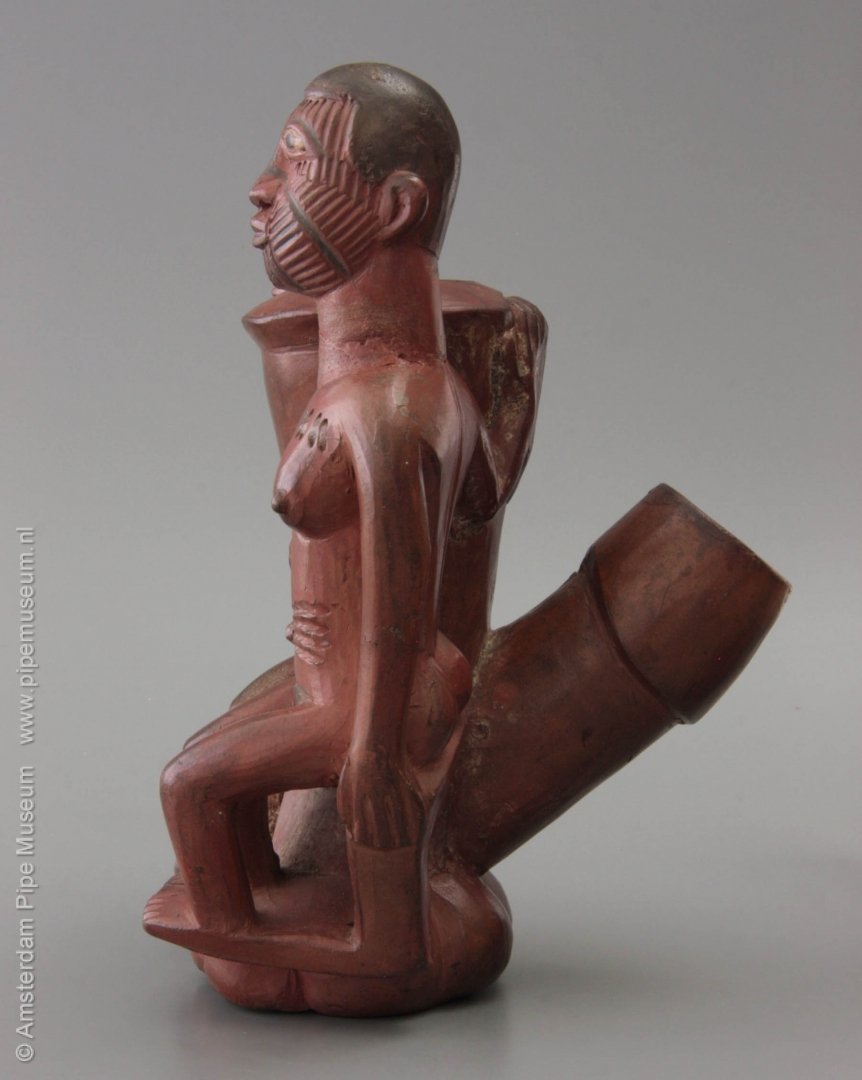
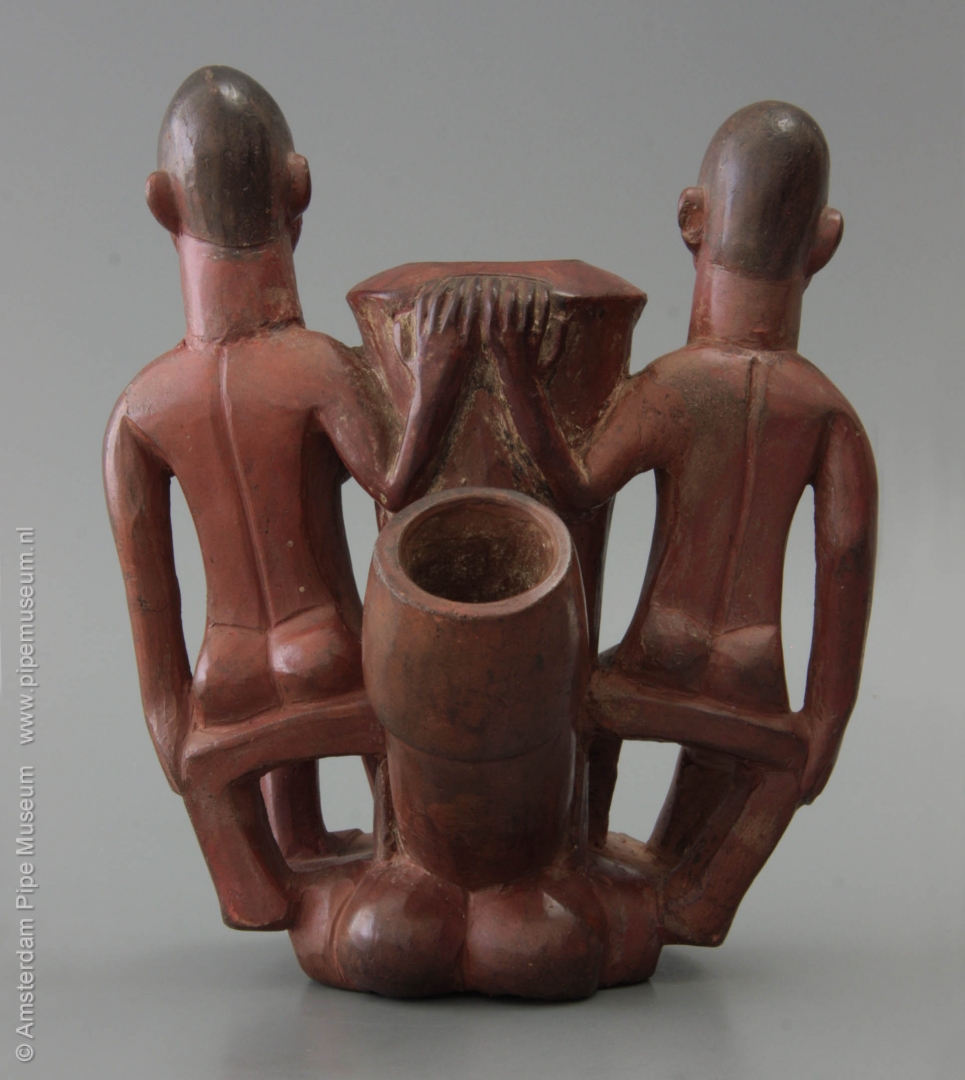
A big difference in body decoration can be seen between the man and the woman. The man has two large incisions in the face, the eyes and eyebrows are also indicated with black dye. What dominates is the red engobe. The woman's body, on the other hand, shows numerous tattoos and especially scarifications. The latter is a common tradition in West Africa in which the skin is injured in such a way that the scar tissue forms a decorative pattern. We see this on the chest as well as on the stomach and even stripes all over the face. Both persons were given extra accents in dye: the hair and pubic hair are accented with black.
The pipe bowl, which is in fact hidden between the seated couple, has a higher-than-usual bowl, indicating a fairly early dating. This also applies to the nodules at the base, which flatten and diminish in number during the nineteenth century. The polished roundness of the pipe bowl is decorated with two inprinted rosettes. The stem is ascending as usual with a flattened cuff band as a finish, which traditionally has the shape of a glans and thus radiates a fertility symbol. It is a detail so widely used with such pipes that the stylization almost makes that meaning forgotten.
The origin is the Gurunsi tribe that has lived in northern Ghana since the early nineteenth century. Their standard pipes of such bowl shape are in daily use and have become widely distributed. Luxuriously decorated specimens like this one, on the other hand, are extremely rare and were rarely smoked. They had a ceremonial role or fulfilled a status function with the owner. Due to the fragile nature of this material, very few copies have survived. For example, this endearing couple is the only one of its kind known to date.
Amsterdam Pipe Museum APM 20.290
Wooden pipe with three people
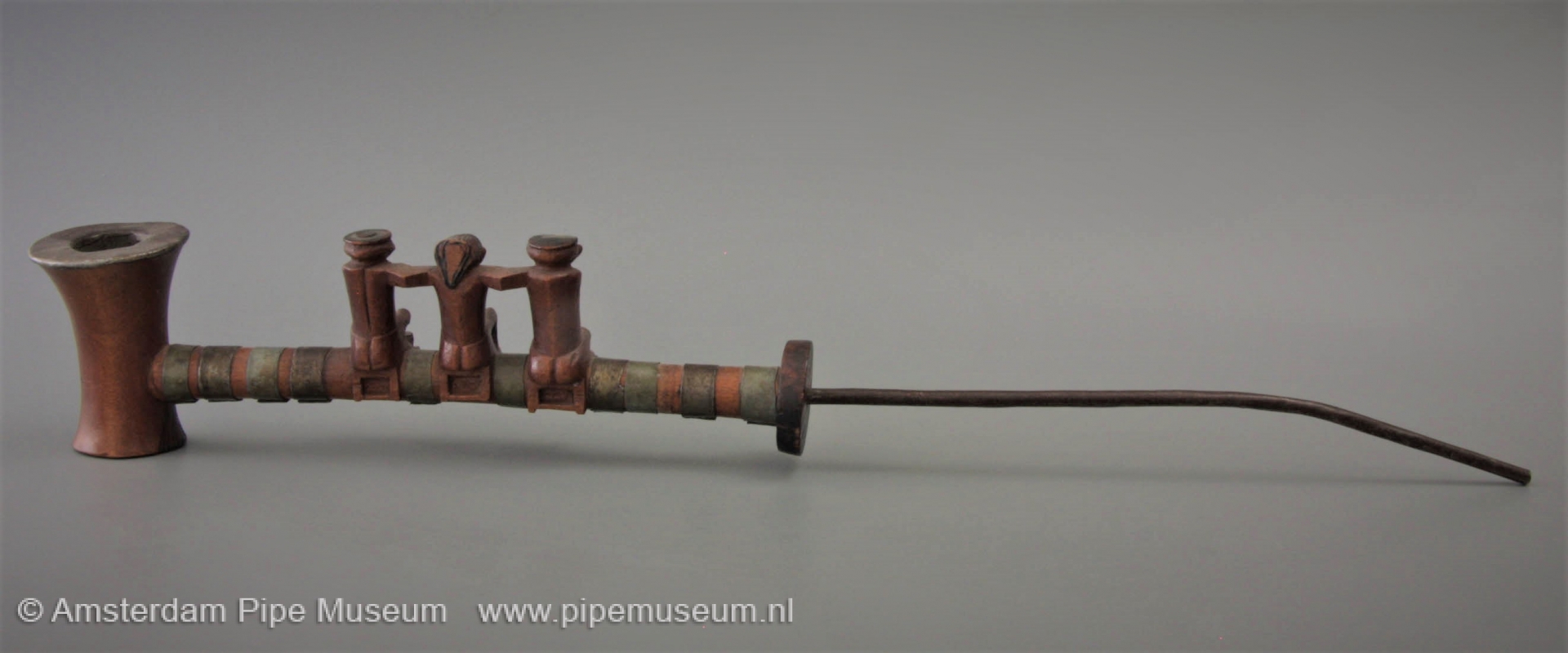
This beautiful pipe must have been taken from Angola by a traveller who stayed there in the first decades of the twentieth century. The tobacco pipe will be bought in the region of the Ovimbundu, a tribe that lives in the border region of Angola with the Congo. Such pipes were ceremonial pipes, called Peshi. The funnel-shaped pipe bowl with flat bottom and also the straight wooden stem with the pronounced disc-shaped end are characteristic of the common local smoking pipe. The use of an iron stem as an extension to the wooden stem is also regular. The figural stem decoration, obviously reserved for more influential smokers, distinguishes this pipe from its everyday counterparts.
On the stem of the pipe three seated figures are depicted, facing left for the smoker. The naked figures are sitting on a kind of platform, a woman in the middle, flanked by two men, their feet are resting on a beam beyond the pipe stem. The carving shows routine and artistry. Only by subtly indicating a few details like the hair, eyes and mouth the representation of the figures is suggested. Some of these details are accentuated with a lick of black dye. More than enough to represent human figures without truthful detailing.
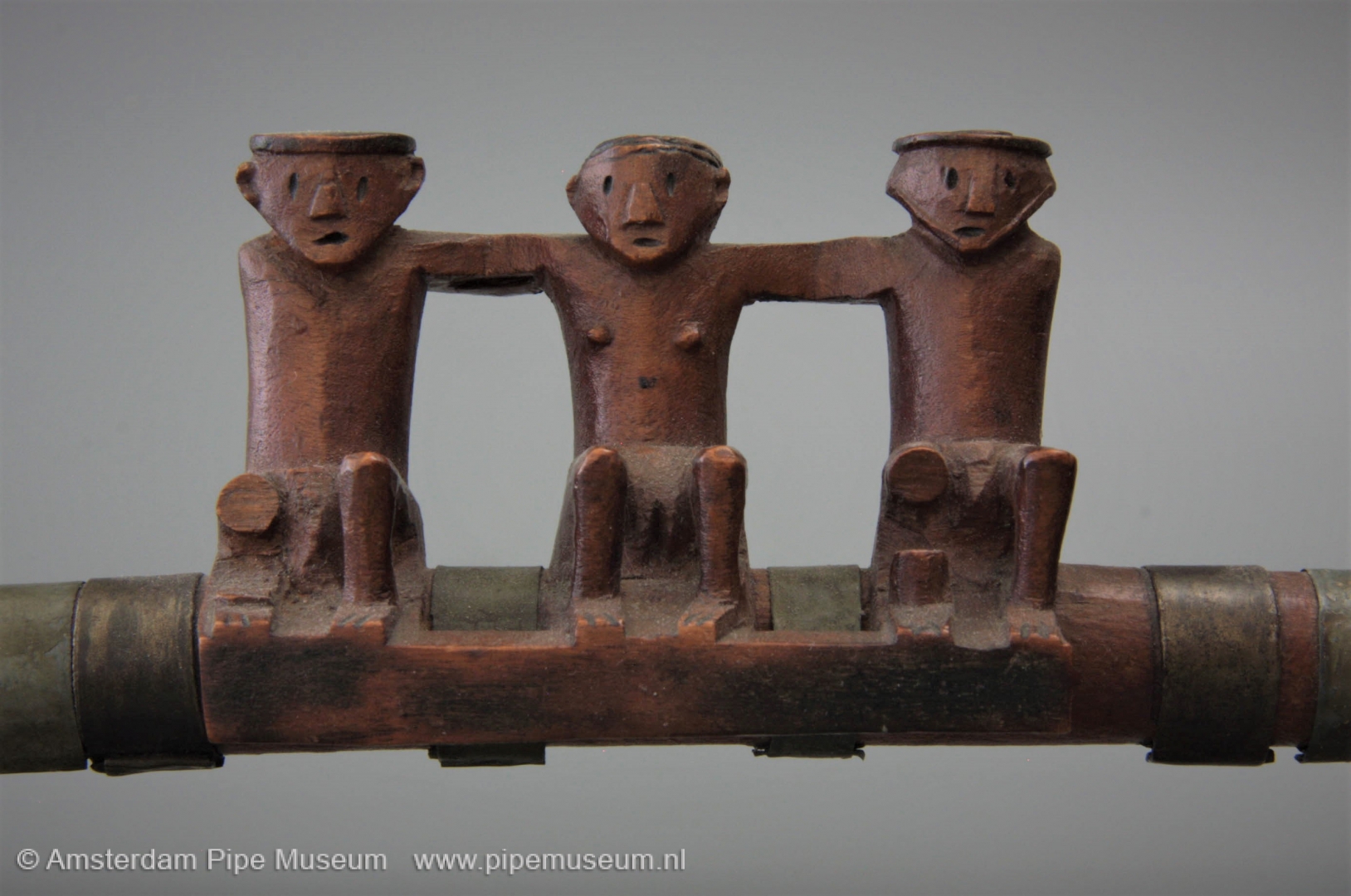
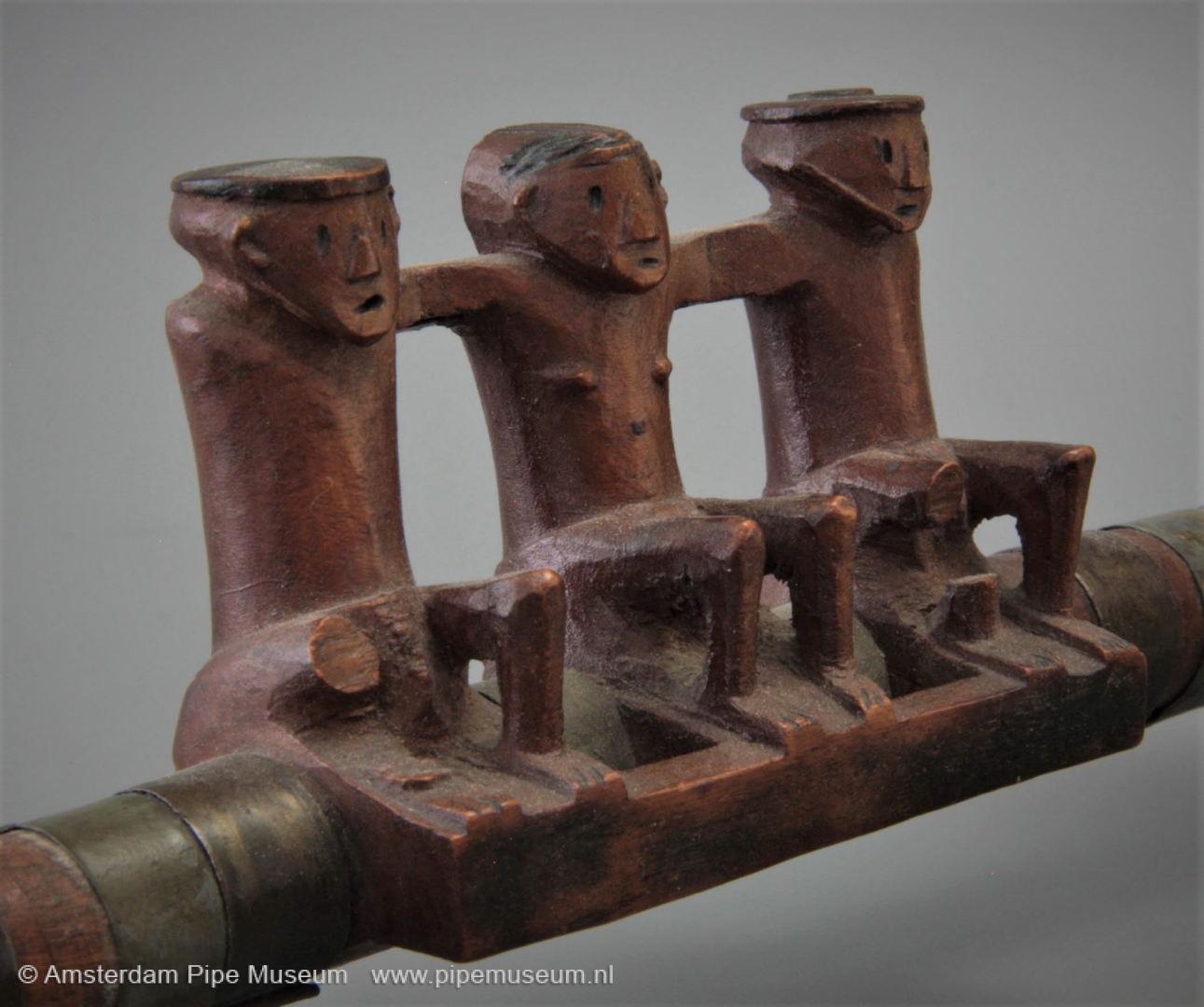
As a reinforcement a series of tin straps in two colours are forced around the straight pipe stem. Additionnally they fulfil a role as decoration. The bowl is internally lined with sheet metal as well which is necessary to protect the soft wood from burning. This metal runs on the flat bowl opening and forms a subtly folded edge on the transition to the wood. The entire object is covered with transparent lacquer to smooth the rough surface. It is possible that this did not happen in the country of origin, but later in Europe.
There is no discussion about the dating of this piece. The characteristics are completely stereotyped for the region, the tribe and the period between 1880 and 1920. Because we do not know how the style of the Ovimbundu pipe developed, an older age is even possible. The oldest written source about this object dates from 1951 when J.H. Kruizinga wrote an article about the collector Henk van der Hoef. In that article, this pipe is mentioned with name and tribe. With these few ephemeral sentences and a group photo, this object is one of the few copies from the Van der Hoef collection that have been documented. Unfortunately in journalistic style without much background knowledge, typical for such writing. The essential details when and where the object was collected were unfortunately lost.
Amsterdam Pipe Museum APM 17.135
Two bowls on one stem
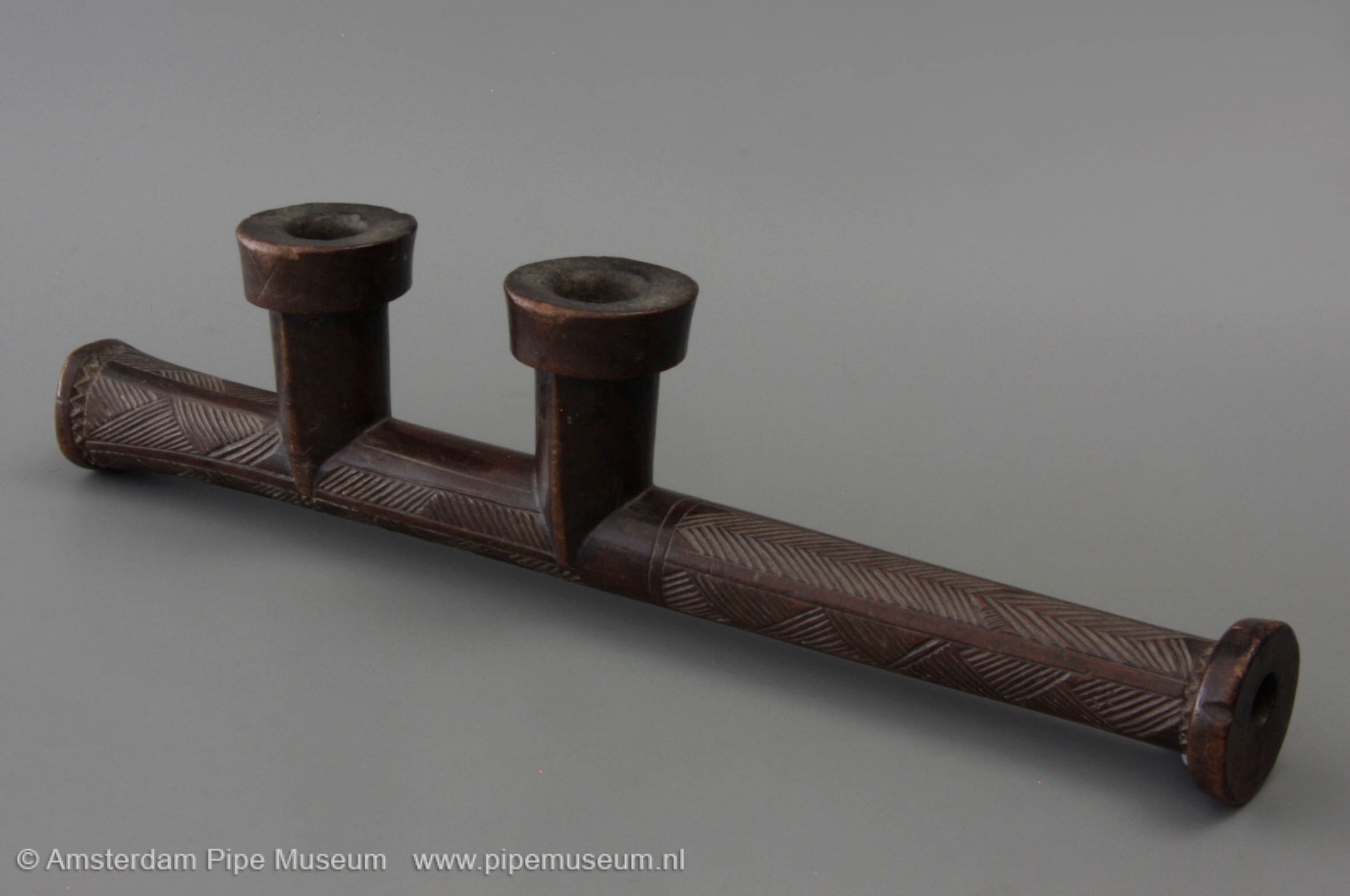
You can can never cease to be amazed about the way peoples shape and decorate their smoking pipes. Regional and tribal-related characteristics prevail in a certain area and have disappeared in another region to make space for other properties. This pipe originates from the Malawi, in the former Nyasaland. It is a wonderful example that shows us features that we cannot find in any other culture.
It is a tobacco pipe made of wood in a really particular shape. The straight stem is cylindrical, rather thick, slightly extending towards the end of the pipe. The front is decorated with four bevelled, slightly hollowed surfaces. At the other end the mouthpiece is shaped like a cylindrical disc. It is not clear whether that is the actual mouthpiece of the pipe that was held against the lips or that a thin metal stem was inserted into it. While this is common practice in the Congo, Angola and elsewhere, no examples of this metal stem have been seen at the Malawi.
The positioning of the pipe bowl, in this case even two, is most peculiar. They are not located at the end of the stem as usual but well in advance, providing a kind of handle behind the pipe bowl. Both bowls are in a right angle on the stem. The two identical bowls are very subtle in shape. Their diameter is not round but slightly flattened with a seam on either side that brings them to the same width as the relatively thick stem. The two bowls join into the stem in an ingenious way. The pipe bowls have a heavily pronounced top edge which corresponds to the mouthpiece.
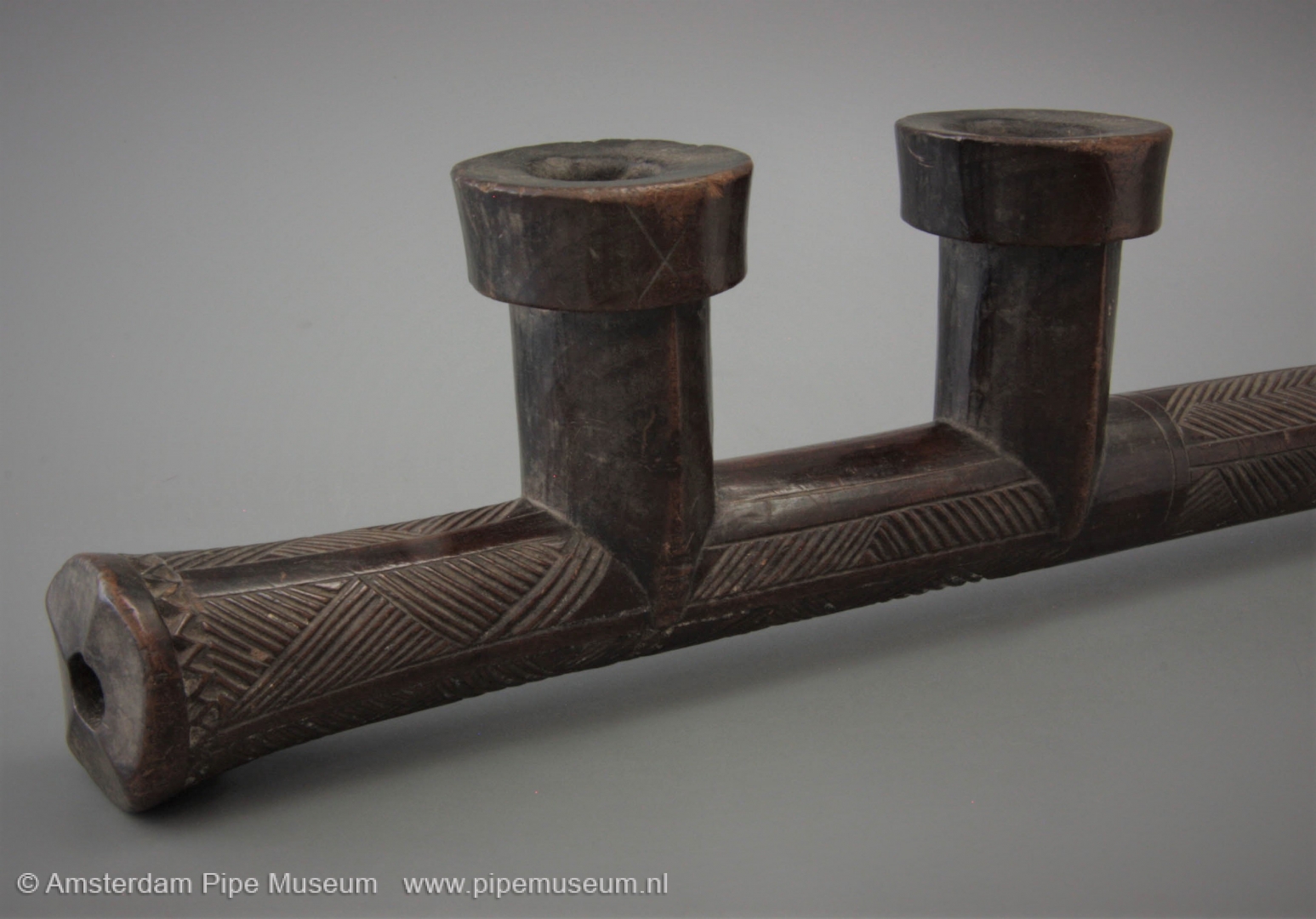
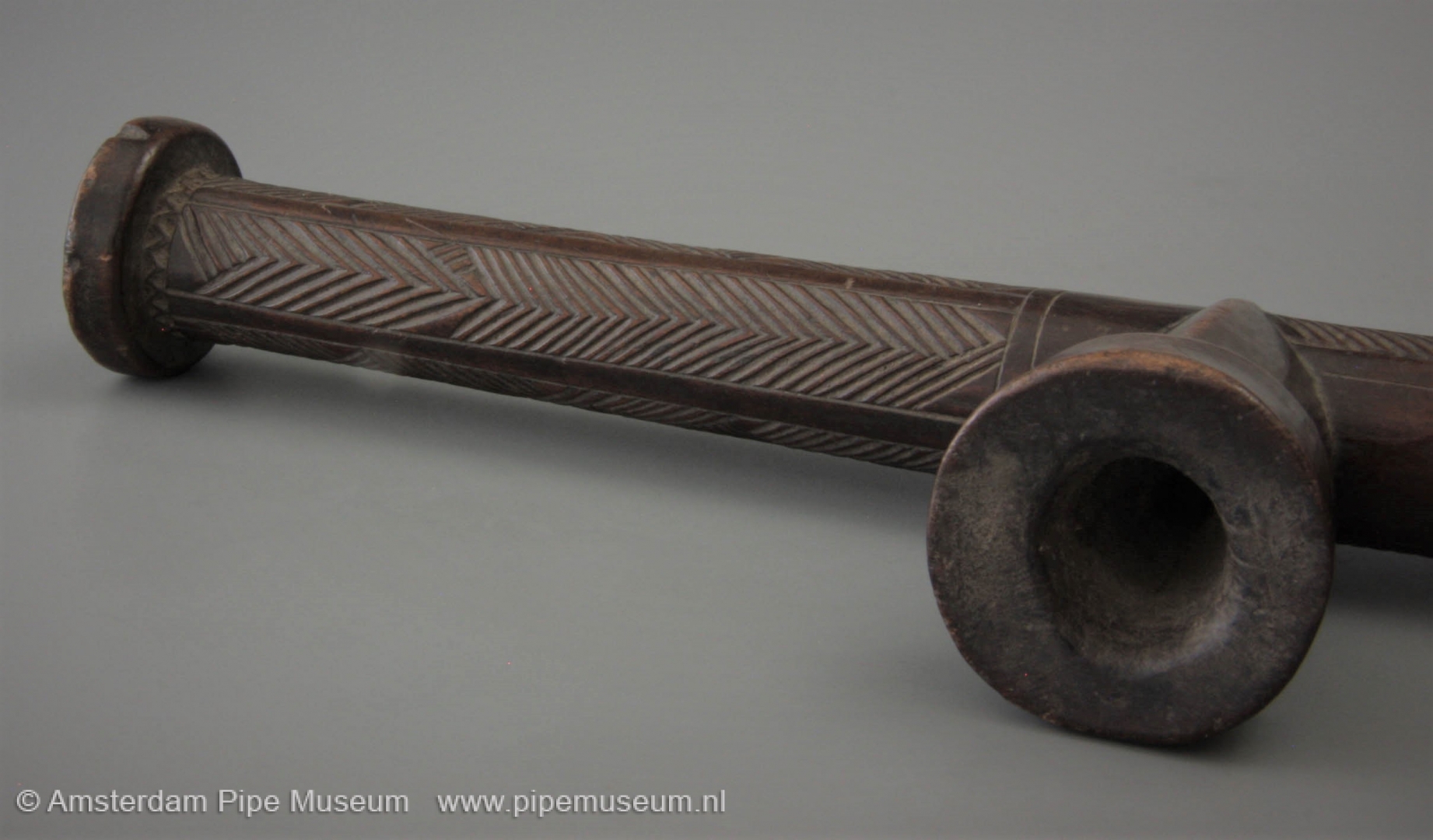
Both pipe bowls have been left undecorated, except for inconspicuous carved crosses on the heavy bowl rims. The stem, on the other hand, has an interesting incised decoration in the kerf-cut technique showing three geometric bands. The first and widest at the mouthpiece, the second between the two bowls and the third on the endpiece. The panels are separated from each other by cut bands with a zigzag line. Although apparently identical, the three panels are filled in differently. The elongated fields were provided with hatches, continuous or herringboned, in other cases made up of triangles with hatchings pointing alternately left and right. The variation in the patterns makes the surface extraordinarily lively, although we should not try to look for a system in the composition. The patterns seem to have been cut out of fantasy, without having devised a specific rhythm in advance.
How the shape of such ethnographic pieces developed, whether it was copied anywhere and when this happened, it is all a mystery. Little is known about the life span of such objects. The style must have existed before 1850 and will remain in use beyond the beginning of the twentieth century. When it disappears is unclear. With a degree of certainty, this piece will date between 1850 and 1920. The curious shape, the high quality of manufacture and the rarity value make this pipe an attractive ethnographic object.
Amsterdam Pipe Museum APM 16.956
Seated figure with headdress
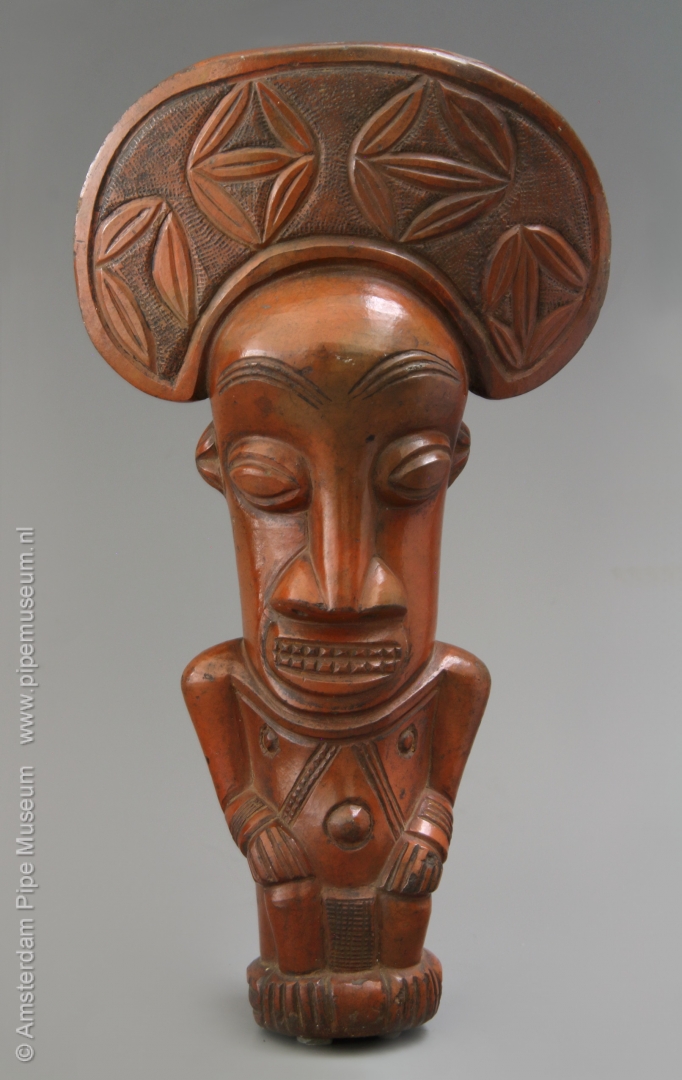
Totem figures such as in the depicted pipe bowl are common representations for tobacco pipes among the Grasslanders of Cameroon. Their pipes have shown such traditional figures for generations, in which the concept remains constant, but details come in an endless variation. This pipe bowl with its sitting totem has a very strong frontal design, with the depiction on the front of the pipe bowl. The strength of the object is further emphasized by the height of almost 25 centimeters.
The bowl shows a seated figure, depicted in a quite majestical pose. The image is dominated by the face, which, with its elongated upright oval shape, takes more than a third of the full image. Characteristic here are the long narrow nose with explicit nostrils, the almond-shaped eyes with above them the quarter-circle-shaped eyebrows and a double row of uniform teeth. Especially striking is the headdress that encloses the forehead with a half moon shape. On the front of this decoration, the maker has applied a repetitive geometric pattern of leaves or pointed coffee beans. If you look very closely, you will see that the right and left are not entirely equal. In his pursuit of symmetry, he apparently did not look good, but saw no way back. In any case, here we clearly recognize the manual work.
The lower half of the pipe bowl depicts the reduced body of the totem figure with a bulging base. Although stylized, the body is clearly articulated with all limbs. Arms run from the widened shoulders along the sides, in this case the hands rest on the knees. Hence we only see the lower legs, with the shaded apron in between. Both fingers and toes are marked with simple but very effective parallel lines, as well as two decorative wristbands. The belly is accentuated with an unmistakable navel.
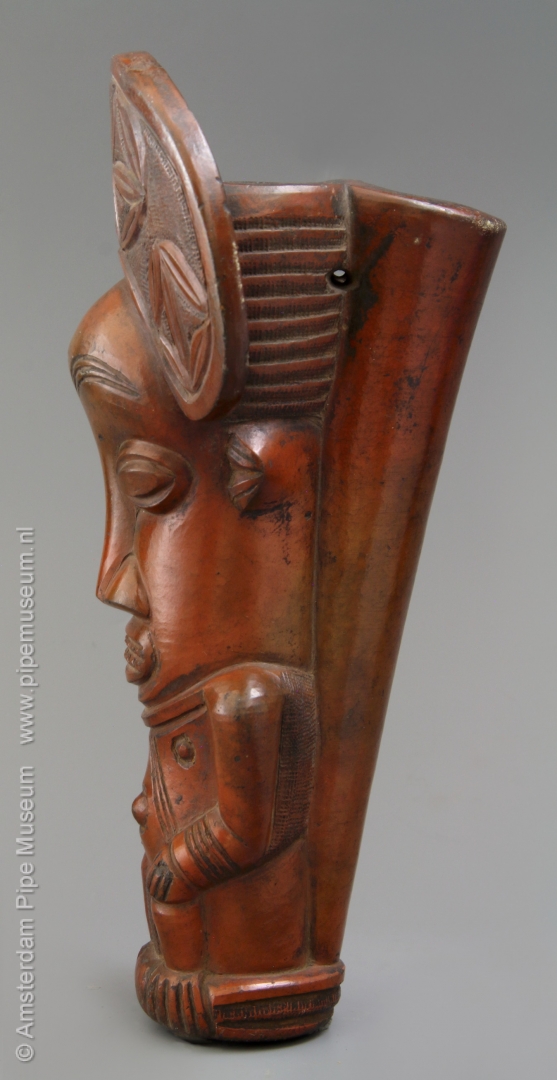
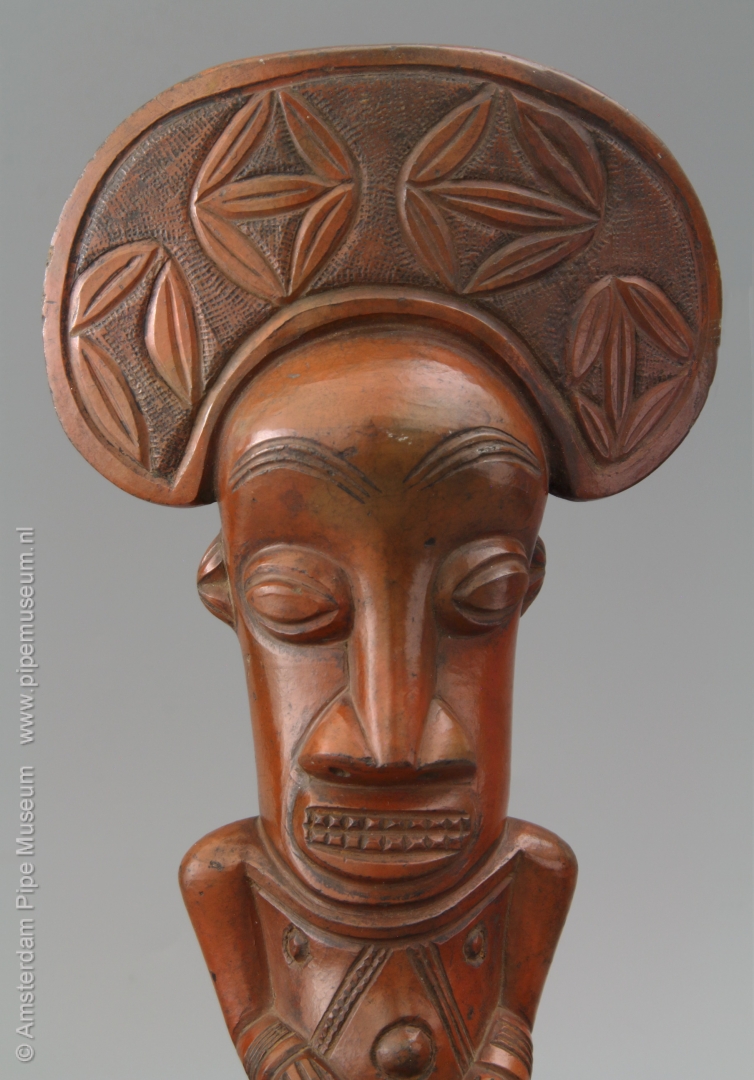
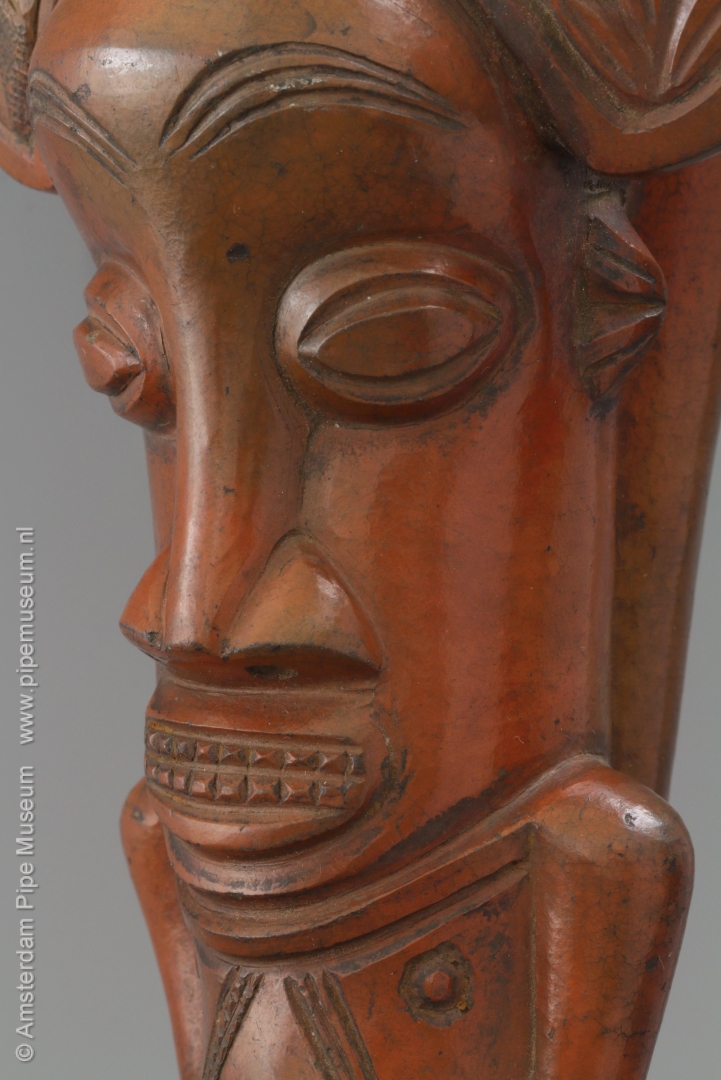
Typical features of the tobacco pipes from Cameroon are furthermore the flat underside of the pipe bowl in which a leakage hole and a rising stem that runs parallel to the pipe bowl and ends without a stub. Between the bowl and the stem there is a hole to attach the pipe bowl to the wooden stem with a locking cord. The stem set-on is undecorated in this case, later a simple geometric pattern is applied as standard. A straight wooden stem was placed in this hollow space as an extension to allow smoking the pipe.
The present object is a beautiful example of a representation according to tradition, yet the pipe stands out thanks to its own design features. The elaboration is extremely careful with powerful lines in a harmonious division of the surface, in one word serene. Your eyes dart from accent to accent. As a matter of fact, the pipe bowl is not modeled, but formed by cutting it from a block of clay. In this case, clay of a rather greasy structure was used, which was polished in a leather-dry state and finally washed with a red engobe. Letting the last furnace fire be oxidizing revealed a beautiful red color, in a matte sheen. This finish is characteristic of the pipe bowls from the beginning of the last century and older. Despite the seemingly one-sided treasure of motifs and fixed design principles, a majestic pipe bowl has been created here.
Amsterdam Pipe Museum APM 24.081
Bead knitting from Cameroon
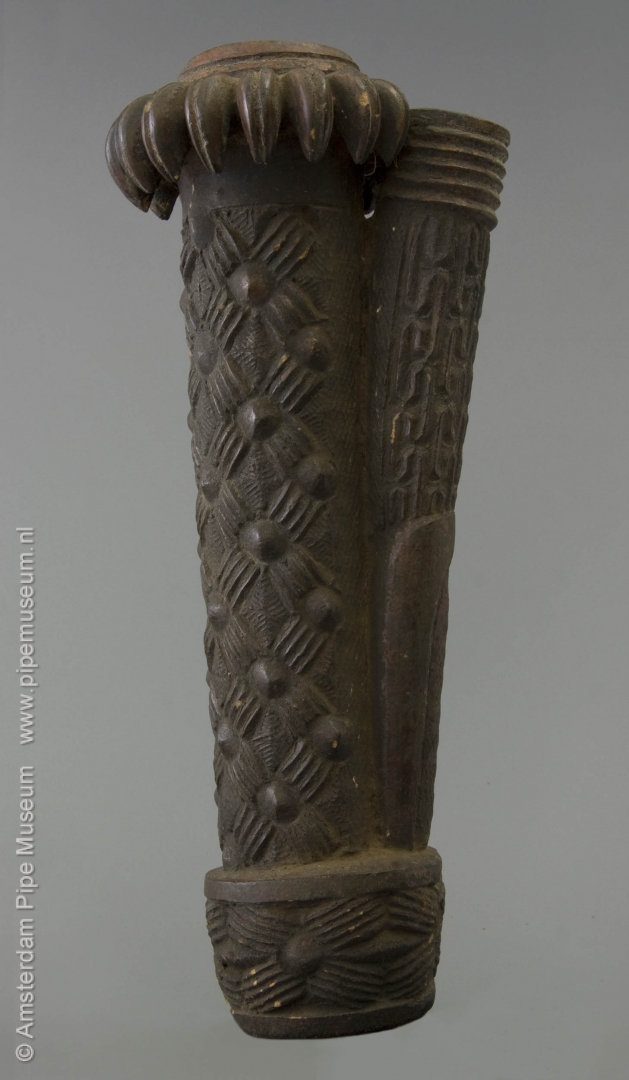
If you believe in the expression the more the better, then this exceptional African tobacco pipe is one of the best. With its length of almost two meters and its bowl height of about thirty centimetres, for sure, it is a huge smoking instrument. The same goes for the pipe stem with extensive bead knitting with thousands of beads. In Cameroon, the tobacco pipe is, apart from a popular smoking implement, a status object. La pipe du chef or Chief Pipe is the large to oversized pipe, which is not meant to be smoked, but has a clear status function as a show piece. Such a pipe is the one shown here.
The earthenware pipe bowl has a high, rather narrow shape and is slightly conical. The bottom is flat with a leak hole, because the used tobacco has a high humidity. Traditionally, the pipes are artfully decorated with a geometric repetitive pattern with a high symbolic value. For example, the bowl shows a decoration incised in the clay consisting of stylized spiders with lozenge-shaped residual space that is shaded to four sides like a diamond head. The edge around the bowl opening is adorned with pronounced lion nails, which enclose the bowl opening like a crown. Finally, the bowl base has been strengthened with four of the same stylized spiders. The stem, nearly parallel to the bowl, is decorated with three different geometrical parts. The bottom is accentuated with an oval roughened panel, the middle has a meandering line and the narrow top edge has five concentric rings.
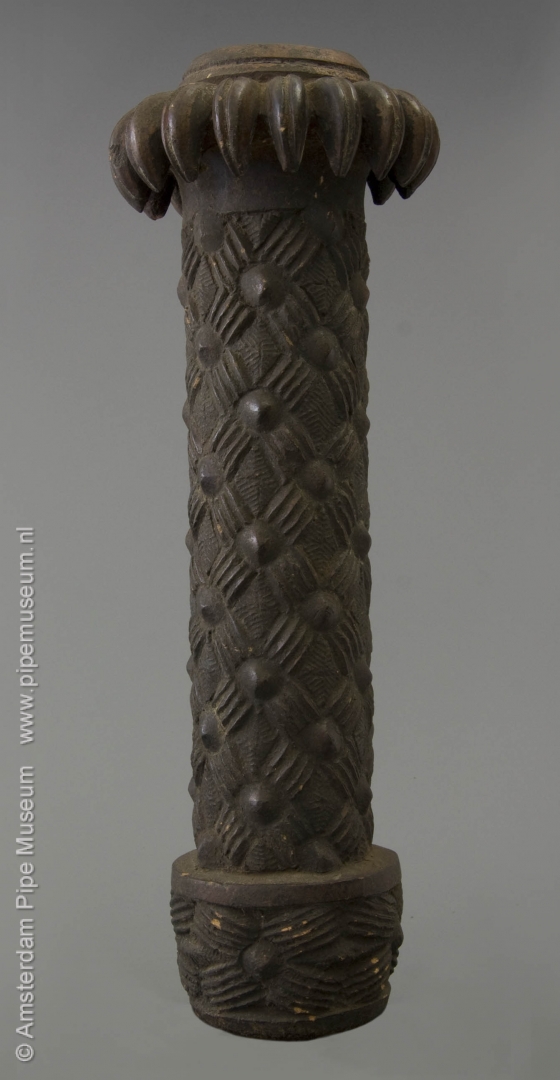
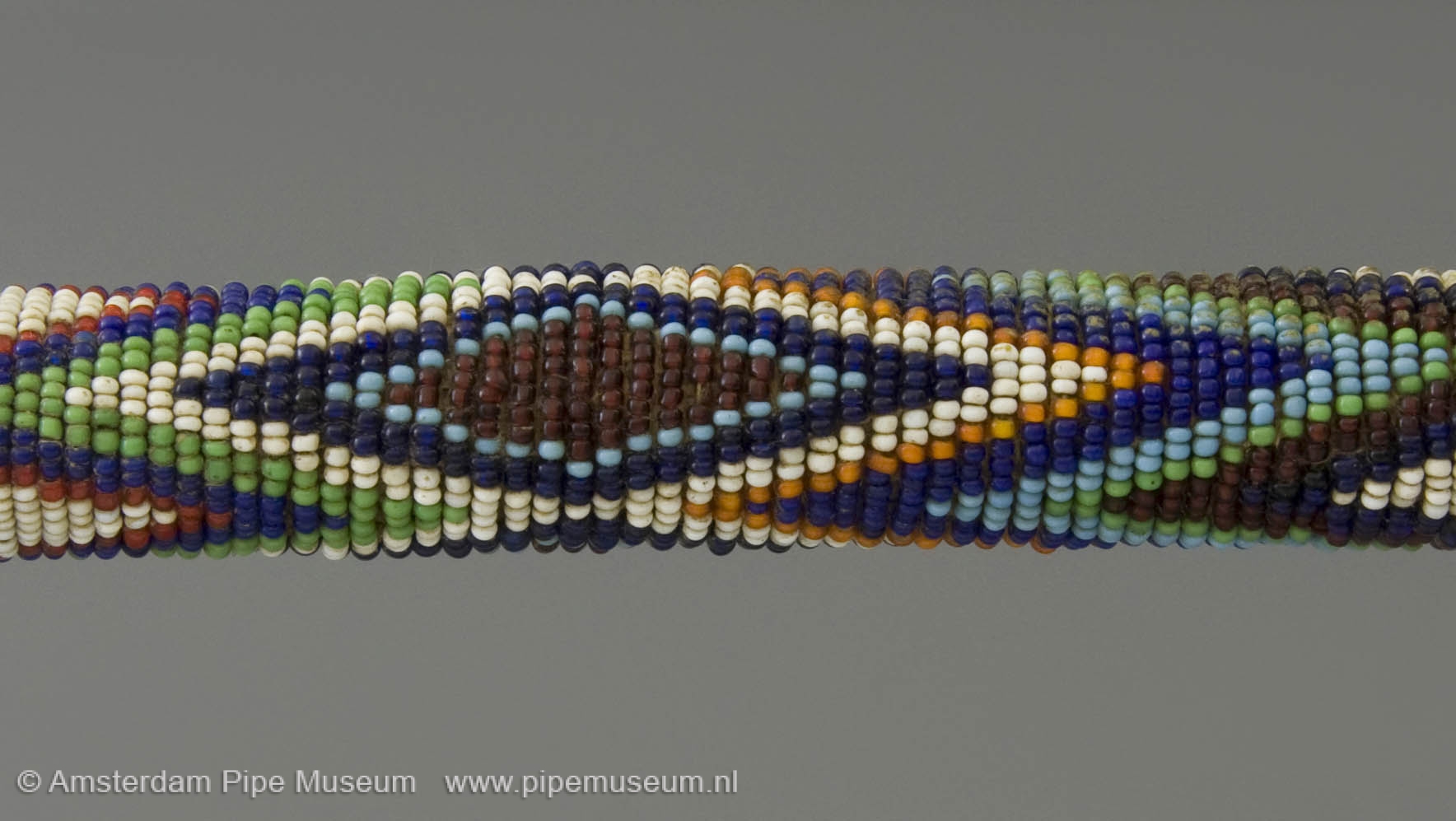
At the time such pipe bowls were made in series and were not built up in soft clay and moulded by hand, but were cut from a block of leather-hard clay. That is why the motifs have a specific design. In the places where the knife in use ended, burr edges can occur. They stand for authenticity in contrast to the hand molded designs of pipe bowls that were made in later times for the tourist market and which look significantly more superficial.

The pipe has its original wooden stem with an incredibly elaborate decoration. A beautiful and colourful geometric braid of glass beads has been applied around the stem. This decoration is made up of alternating bands with triangles and overlapping diamonds. The repetitive pattern evolves from simple and explicit to more refined and more complicated. Because the stem is thinning towards the mouthpiece and at the same time the decoration is getting more detailed, a very special effect is achieved. How labour-intensive this work has been, is evident from the fact that about 27,600 beads have been used!
The wooden stem is topped by a detachable mouthpiece of cast bronze that fits over the end with its slightly tapered shape. One end has an inconspicuous pearl edge, while the stem end is provided with a disk shape. Although it is not a very striking part, the bronze contrasts beautifully with the shiny beads and the matt dark pipe bowl.
Such grand pipes were not smoked, but served as a promotional gift to a high-ranking person. On official occasions they were carried around in order to underline the status of the owner. It is unclear who ever owned this pipe. After unkown wanderings, this specimen popped up in Madrid in 1988 and was sold at auction, along with four other royal pipes. Since then, this pipe dominates the extensive collection of Cameroon pipes in the Amsterdam Pipe Museum.
Literature: Don Duco, Smoking utensils full of symbolism, tobacco pipes from the Grasslands of Cameroon, Amsterdam, 1999.
Amsterdam Pipe Museum APM 15.885